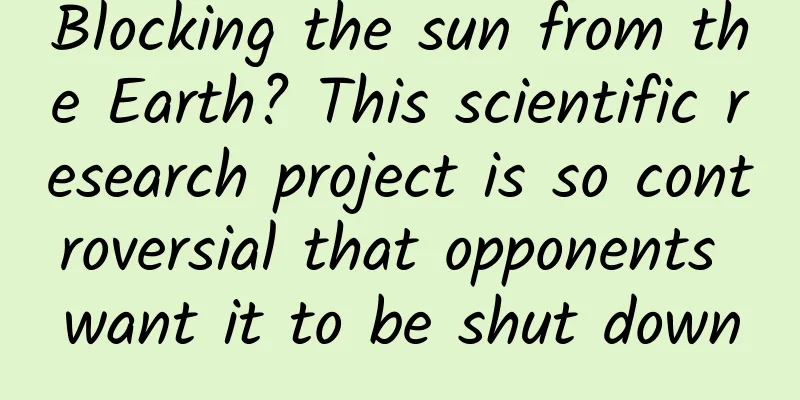Blocking the sun from the Earth? This scientific research project is so controversial that opponents want it to be shut down

|
As an emerging research field, scientists have come up with a variety of strategies for solar geoengineering. However, the most difficult part of promoting this project is not the idea, but the actual experiment. Because no one can predict what impact it will have on the environment. The problem is that opponents now want to kill it in the cradle and simply not conduct experiments. Written by | Du Baojie On March 18, an engineering experiment led by Frank N. Keutsch, a chemistry professor at Harvard University, was officially terminated. The engineering experiment, called SCoPEx (Stratospheric Controlled Perturbation Experiment), is co-funded by Bill Gates and aims to study the effects of spraying particles into the stratosphere, which could theoretically reflect some sunlight and have the effect of cooling the Earth. However, the test has faced huge controversy over concerns it could tamper with the atmosphere in unprecedented and potentially dangerous ways, and has finally come to an end, 10 years after it was first conceived. This is just the latest setback for solar geoengineering. Just 20 days ago, the field suffered a setback that cast a shadow over the entire field. “Outrageous” claims From February 26 to March 1, 2024, the Sixth United Nations Environment Assembly (UNEA-6) was held in Kenya. As the world's highest-level decision-making body on environmental issues, a theme throughout the conference is: The Earth is at a critical point, and humanity must take urgent action to address the triple global crisis, namely climate change, nature loss and environmental pollution. Seeking sustainable development is a global consensus. Representatives from 182 countries reviewed more than 20 drafts and finally passed 15 resolutions. It should be said that the approval rate is still quite high, but the proposal led by the Swiss expert group to establish solar radiation management (SRM) and implement solar geoengineering has caused many scientists to be extremely worried about the unknown risks of "artificial sunset" due to major differences. The frustrated Swiss were eventually forced to withdraw the resolution, muttering "disappointing". Figure: Different forms of solar geoengineering | Source: NOAA/CIRES This is not the first time that SRM has been formally proposed. As early as 2019, Switzerland proposed to evaluate the scientific nature and possible effects of "climate change technology" (also known as geoengineering). Geoengineering refers to all actions that attempt to artificially change the climate of the earth itself. After revisions and improvements, the implementation of solar geoengineering through SRM has become a special theoretical branch that aims to change the earth's climate by blocking the sun's rays with reflective materials. Supporters believe that if solar radiation can be reflected, the earth's climate will become colder in the short term. The basic logic is that simple. However, whether the current environment has reached the point where the "last resort" should be implemented on a large scale, or whether local experiments should be conducted to test the effectiveness of SRM and carry out preventive management, has become the most tangled point for the entire environmental science community. So, is it really outrageous to propose such a controversial scientific hypothesis? Let's start with the unstoppable global warming. Due to excessive carbon emissions caused by human activities, the earth is warming rapidly. Ordinary people may just feel that the weather has become more and more abnormal in recent years, but environmental scientists are already worried about it. Figure: Estimation of global warming | Source: Climate Action Tracker In 2019, the United Nations Environment Programme released a bleak environmental report, Emissions Gap Report 2019, which pointed out that even if countries implement all commitments under the Paris Agreement, which came into effect in 2016, the rate of global greenhouse gas emissions will still cause the global average temperature to rise by 3.5°C by 2100 (range 3.4–3.9°C, probability 66%). Unless global greenhouse gas emissions fall by 7.6% annually between 2020 and 2030, the world will lose the opportunity to achieve the 1.5°C temperature target of the Paris Agreement. At the same time, the Intergovernmental Panel on Climate Change (IPCC) has also warned that warming above 1.5°C will significantly increase the frequency and intensity of extreme climate impacts. Source: UN News Data shows that the observable rate of climate change in the past 50 years is twice that of the past 100 years, and the first 20 years of the 21st century have repeatedly set new highs in temperature. The temperatures in many countries and regions have broken historical records. Extreme high temperatures of 38°C to 45°C have become common, and deaths caused by heat waves have become more and more frequent. On November 30, 2023, the World Meteorological Organization warned that 2023 will be the hottest year in human history since records began, and various climate change indicators have reached "off-the-charts" levels. As global greenhouse gas emission reduction efforts and results are far below expectations, scientists are increasingly frustrated and even panicked about the climate crisis. In addition to reducing emissions, do we have any other options? Some scientists have come up with the idea of geoengineering, the goal of which is to artificially intervene in the climate through a series of technical means to reduce or offset climate change caused by global warming. These technologies broadly fall into two distinct paths: one that absorbs carbon dioxide from the atmosphere (carbon capture and storage) and the other that reflects sunlight before it reaches the ground, a process known as solar geoengineering. However, the effectiveness of most of these techniques is unproven. In theory, the cost of removing carbon dioxide on a large scale is very high and requires a lot of energy and resources. There will also be huge logistical challenges in the large-scale deployment of such technologies. In the eyes of supporters, solar geoengineering is a cheaper, faster and more direct way to control global warming. They hope to at least regard this as a "last resort" to fight global warming, and actively carry out experimental research first, just in case. Scientists' ideas and progress As an emerging research field, the various strategies proposed by scientists for solar geoengineering are truly mind-blowing. For example, by injecting special aerosols into the stratosphere to simulate the cooling effect of the earth caused by volcanic eruptions; or by "bleaching" the clouds or "coating" the ocean to increase the reflectivity of sunlight; or by setting up a special "space mirror" between the earth and the sun to regulate the solar radiation reaching the earth. But the hardest part about implementing solar geoengineering isn’t the conception, but conducting actual experiments. Brightening clouds to mitigate global warming was first proposed by British physicist John Latham in an article in Nature magazine about 30 years ago. He proposed deploying fleets of spacecraft to spray tiny salt particles into low-lying clouds over the ocean. The particles would cause more water droplets to form, creating larger, denser, whiter clouds that would reflect more heat back into space. Decades have passed, and no team has said that it will be easy to deploy solar geoengineering, because no one can predict what impact it will have on the environment. Figure: Schematic diagram of the effects of solar geoengineering methods | Source: The Conversation US, Inc. Since 2017, scientists from the University of Sydney and the Sydney Institute of Marine Science have conducted several experiments on the Great Barrier Reef. The project is small-scale and involves pumping seawater onto ships and spraying it into the sky from nozzles. The project leader said that the fog machine needs to be expanded tenfold to about 3,000 nozzles to brighten nearby clouds by 30%. After years of testing, the project has not yet produced peer-reviewed empirical evidence that cloud brightening can reduce sea surface temperatures. And all these ship machines will pump and spray large amounts of seawater for months in the summer. Even if it works, it is difficult to be "environmentally friendly" as its supporters say. There is also a study called the Arctic Ice Project, which focuses on a key factor in the Arctic crisis: melting sea ice. By covering key parts of the Arctic with a thin layer of tiny hollow glass microspheres (HGM), the melting of polar ice is slowed down by increasing reflectivity and weakening the absorption of solar energy, thereby stabilizing the global climate. But recent research by scientists shows that these spheres actually absorb some sunlight and accelerate the loss of sea ice under certain conditions. Figure: Changes in the Arctic and Pacific ice environment | Source: AGU The Harvard University SCoPEx project mentioned above was once considered the most reasonable form of solar geoengineering - it was based on real natural phenomena. For example, when Mount Pinatubo in the Philippines erupted in 1991, it released a large amount of aerosols, and scientists observed that the temperature of the earth dropped by 0.4 °C in the next two years. SCoPEx envisions using a fleet of specialized jets to spray relatively small amounts of sulfate aerosols (or similar particles made of calcium carbonate) into the stratospheric atmosphere to reflect sunlight, mimicking the effects of some large volcanic eruptions. In 2021, a team of researchers from the SCoPEx project plans to conduct an experiment in the northern Swedish town of Kiruna, with the help of an aerospace company, to spray particles about 12.5 miles above the Earth's surface for observation and research. The first flight was just a test run of the instrument and the power pod of the high-altitude balloon. But shortly before the Harvard independent advisory committee was expected to approve the project, a Swedish environmental organization and the Council of Aboriginal Peoples sent a letter requesting the cancellation of the project. SCoPEx was therefore shelved. Although the release substances used in their experiments were small amounts of calcium carbonate or sulfate, which are common minerals or detergents, local residents still felt that the atmospheric composition would become unsafe. Image: Experimental balloon ready to launch | Source: SCoPEx To reduce public opinion obstacles and concerns, in 2022, the Massachusetts Institute of Technology (MIT) proposed a space-based solution for solar geoengineering, known as the "space bubble" plan. The MIT scientific team said this is the first research proposal to use reflective film in outer space, which is easy to deploy and completely reversible. They believe that deflecting 1.8% of solar radiation could completely reverse global warming. The bubbles could be manufactured and deployed directly in outer space to form a large-scale deflection raft located near the Lagrange point between the Earth and the Sun. The entire space bubble raft would need to be roughly the size of Brazil. At the Lagrange point, the gravitational effects of the Earth and the Sun cancel out, ensuring that the raft remains in place and providing the ability to move the bubble closer to the Sun for optimal impact. Figure: "Space Bubble" concept | Source: MIT It may not be difficult to create a cryo bubble in a space environment, but the construction of such a large "space bubble" requires an interdisciplinary team of scientists from architecture, civil and mechanical engineering, physics and materials science to complete, and requires the support of relevant global resources. It is feasible in theory, but it is a bit sci-fi in implementation. So far, the various solar geoengineering experiments, with mixed results, have not yet provided encouraging answers. More fear of the unknown Sunlight is indispensable for the survival of all living things on Earth. No one knows what the consequences will be if human intervention is excessive. This is the starting point of many opponents of solar geoengineering: if it is a disaster, no one can afford ecological consequences more terrible than global warming. Figure: Solar Geoengineering Non-Use Agreement Organization | Source: solargeoeng.org Following the latest UN controversy, three researchers from James Cook University in Australia and Wageningen University in the Netherlands continued their attack on solar geoengineering, writing in The Conversation that it is a “dangerous distraction.” They argue that calls for outdoor trials of these technologies are misguided and will divert our attention and resources from phasing out fossil fuels. In fact, in 2022, more than 500 scientists and scholars from 61 countries signed an open letter calling on governments and the United Nations to "ban" solar geoengineering. They mentioned three basic issues in the open letter: First, the risks of solar geoengineering are poorly understood and will never be fully known. The impacts will vary from region to region, and there are uncertain effects on weather patterns, agriculture, and the supply of basic needs such as food and water. Second, speculation about the future availability of solar geoengineering technologies could inhibit and interfere with current decision-making by governments, businesses, and society to do their best to achieve decarbonization or carbon neutrality as quickly as possible. Third, the current global governance system is ill-suited to developing and implementing the far-reaching agreements needed to maintain fair, inclusive, and effective political control over solar geoengineering deployment. The letter then proposes core prohibitions and measures that the international community should abide by: 1. Commit to prohibiting national funding agencies from supporting the development of solar geoengineering technologies domestically or through international agencies. 2. Commit to ban outdoor testing of solar geoengineering technologies within their jurisdictions. 3. Commit to refuse to grant patents on solar geoengineering technologies, including related supporting technologies, such as the technology to modify aircraft to inject aerosols. 4. Commit not to adopt solar geoengineering technologies developed by third parties. 5. Commit to not institutionalize global-scale solar geoengineering as a policy option for relevant international institutions in the future, including as part of the assessment of the Intergovernmental Panel on Climate Change. David W. Keith, a professor of applied physics and co-sponsor of the SCoPEx project, likened these critics to skeptics of air bags, who say their presence in cars encourages more dangerous driving. “People may be a little more careless in the way they drive now because cars are safer," he said. "But that’s not a bad thing.” However, the public may not buy into this argument. After all, in movies, TV shows and novels, solar geoengineering has been portrayed as an evil thing. For example, in the 2013 Korean movie Snowpiercer, scientists released CW-7 coolant into the sky to stop the spread of global warming, but they did not expect that the plan would push the earth into an abyss of extreme cold from which there would be no return. How similar is this to the concept of the SCoPEx project? Image: United Nations Environment Assembly | Source: legal-planet.org In addition to the differences within the scientific community, the attitudes of developed countries, developing countries and backward countries are also completely different. For example, some countries adhere to the principle of "science first" and avoid "prejudging" the feasibility of SRM. Many developing countries hope to include social, legal, ethical, human rights, geopolitical and security aspects and how to govern in the assessment "database". Some vulnerable countries also believe that the deployment of SRM is illegal and even believe that such research needs to be banned. Most countries participating in UNEA still said that they did not know enough about SRM, especially the risks. There were gaps in the knowledge hierarchy among countries, and there was a dispute over who would take the lead. How to prevent SRM from falling into the hands of political and commercial interest groups was also a problem. The final decision was not to deploy it in the short term. Nevertheless, there are no specific international measures to prevent research in more developed countries (such as the United States and the United Kingdom) from continuing to be funded through social initiatives and conducting small-scale trials in some developing countries. In addition, some private companies are seeking to commercialize SRM, and research on preventive management of SRM seems to be becoming increasingly urgent. The end is also the beginning As the dust settles on this year’s UNEA-6 conference, countries have lost an opportunity to discuss knowledge sharing and research governance on SRM. The research race among leading countries is likely to escalate, while other countries will have to rely on their own means to deal with the scientific, political, ethical and human rights challenges brought about by SRM, or passively adapt to the impacts of global warming. It is worth noting that although Switzerland’s proposal on SRM was controversially withdrawn again at the United Nations Environment Assembly, in this context, the World Climate Research Programme (WCRP), a subsidiary of the International Science Council (ISC), launched a climate intervention research "Lighthouse" Action (LHA) in February 2024, aiming to carry out ambitious interdisciplinary research to better manage climate risks and meet the scientific and institutional framework required to meet society’s urgent needs for reliable and actionable climate information. WCRP’s climate intervention topics include large-scale carbon dioxide removal and storage technology (CDR) and solar radiation regulation (SRM). Through global inclusive research and comprehensive assessment, a reliable way out of controversy or a clearer final answer may be found for solar geoengineering in the future. References and Literature [1] https://agupubs.onlinelibrary.wiley.com/doi/full/10.1029/2022EF002815 [2] http://stdaily.com/index/kejixinwen/202312/85b4da099c034002892a8ed7ee4397f7.shtml [3] https://legal-planet.org/2024/03/08/the-global-conversation-about-solar-geoengineering-just-changed/ [4] https://www.solargeoeng.org/media/media-kit/ [5] https://climateactiontracker.org/global/temperatures/ [6] https://theconversation.com/not-such-a-bright-idea-cooling-the-earth-by-reflecting-sunlight-back-to-space-is-a-dangerous-distraction-223353 [7] https://senseable.mit.edu/space-bubbles/ [8] https://www.unep.org/resources/emissions-gap-report-2019 [9] https://zh.wikipedia.org/wiki/%E5%85%A8%E7%90%83%E5%8F%98%E6%9A%96 [10] https://news.un.org/zh/story/2024/03/1127461 [11] https://www.thecrimson.com/article/2024/3/20/harvard-geoengineering-project-abandoned/ This article is supported by the Science Popularization China Starry Sky Project Produced by: China Association for Science and Technology Department of Science Popularization Producer: China Science and Technology Press Co., Ltd., Beijing Zhongke Xinghe Culture Media Co., Ltd. Special Tips 1. Go to the "Featured Column" at the bottom of the menu of the "Fanpu" WeChat public account to read a series of popular science articles on different topics. 2. Fanpu provides a function to search articles by month. Follow the official account and reply with the four-digit year + month, such as "1903", to get the article index for March 2019, and so on. Copyright statement: Personal forwarding is welcome. Any form of media or organization is not allowed to reprint or excerpt without authorization. For reprint authorization, please contact the backstage of the "Fanpu" WeChat public account. |
<<: God Particle: Exploring the Mysterious Origin of Mass
>>: The alarm is ringing, but I advise you to sleep a little longer!
Recommend
3 days, 0 budget, sales of 10,000 goods, all the activity methodology is here!
The article combines the author's actual expe...
Why should I advise you to really stop “bearing the pain”?
Whether it is a cold, fever, sprain or gum inflam...
Before going online, what operational and promotional actions should a To B product take?
Even good wine needs no bush. In this era of info...
Can you really get over your ex? It might be hard...
Leviathan Press: If you were asked to recall and ...
3 tips for creating explosive short videos
As we all know, the post-epidemic era has acceler...
How does the space environment affect astronauts? Heart chips reveal changes in astronauts after a month in space
Tuchong Creative Two astronauts from NASA were de...
The ocean is running a fever: Will extreme weather bring us into an era of "boiling"?
The ocean is one of the most important parts of t...
Characters | Han Xiqiu: The female chief who searches for the "black chimney" on the seabed
She has been with the sea for thirty years and ha...
Have you not yet distinguished between "fog" and "haze"?
Is it fog or haze? Environmental Science Autumn a...
The right bank of the Irtysh River: the colorful hill
Most of the rivers in Xinjiang are inland rivers,...
The place where water is released at night in Wuhan, a good place to release water for health
Wuhan Tea Tasting Contact Information I strongly ...
When eating meat during the Chinese New Year, you must choose the best! When buying beef, knowledgeable people choose these 6 parts
When eating meat during the Chinese New Year, you...
As users, we can be well prepared, but when we are in a relationship, it is really difficult if the other person changes every moment.
I seldom mention my love life in my articles. Fir...
From source of infection to technological pioneer, can scientists really turn mosquitoes into "anti-malaria assistants"?
Mosquitoes have always been regarded as one of th...
The most practical seed user operation method
I have been wanting to talk about the seed user o...


![[Promotion] Future applications: No matter how fancy your H5 is, what’s the use if there is no traffic?](/upload/images/67cc3b11cdc60.webp)






